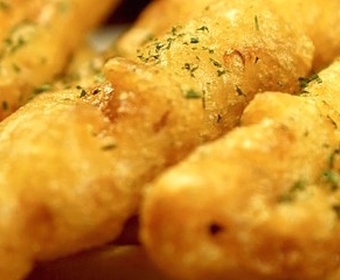
Coating fish
- A crispy coating adds flavor, mouth feel and supports fragile fish meat
- Not too high, not too low temperature
- There are many types of coating
Coating can make lean, white fish a more exciting experience. It provides a crispy mouth feel and soaks up flavors from the fat when frying. Coating can also make it easier to fry fish meat that has a tendency to fall apart. The batter turns into a shell that keeps the sensitive protein in place and stops it from sticking to the hot surface of the pan.
The right temperature
When frying coated fish, using the right temperature is crucial. If the heat is insufficient the protein will release large amounts of water which will make the coating come loose from the fish. If the heat is excessive the coating will burn before the fish is cooked. Therefore the pan and the fat should be very hot when you start frying, but you can lower the heat as you proceed.
When breading fish:
• Cod, saithe, haddock and other fish in the cod family are among the trickiest to fry. Coating them is a common way to help the protein stick together in one piece.
• Fry one side until perfect. Flip the fish and put it in the oven. This way both sides will be perfect when you take it out again.
• For Japanese “panko” bread coating a flavorless oil works best.
Flour coating
Simple coating, à la meuniere, is an uncomplicated affair. The method works well for relatively solid, whole fish fillets where you want to alter the taste and character of the fish as little as possible. Add salt and pepper and dip the fillets in flour. Fry them for a few minutes on each side in a mixture of oil and butter (added to the pan in that order).
Bread coating
Double coating is probably the most common way to coat fish destined for the frying pan. Add salt and pepper and then dip the fish in flour, after that in a beaten egg, and after that in breadcrumbs. This method is suitable for fish with fragile meat, such as the cod family. Fry the fish in a mixture of oil and butter (added to the pan in that order).
Egg coating
A suitable method for fish fillets with solid meat, resulting in a golden brown and succulent “shell”. Add salt and pepper and dip the fillets in flour and then in a beaten egg. Fry carefully at medium high heat.
Spice coating
Technically, this is the same thing as bread coating, but with more flavors added. It works well for whole fish and fish cutlets fried in an oven. Mix grated cheese (mature and "dry" and with a lot of flavor) into the breadcrumbs – or sesame seeds, lemon peel, finely chopped herbs, chopped nuts, paprika powder, and so on. Or use shredded coconut instead of breadcrumbs.
Piccata
An Italian specialty, the point being to bring out the flavors in fried meat or fried fish with grated Parmesan cheese. Mix the finely grated cheese, salt and pepper into a beaten egg. Dip the fish in flour and then in the Parmesan and egg. Fry the fish in a hot pan – but be prepared to bring the temperature down.
Glutenfree coating – chickpea flour
Coating with flour and/or bread contains – there is no getting around it – gluten. A perfect alternative when coating fish – or any other food - is chickpea flour. If you get the surface golden brown and just right, it has a wonderful nutty flavor. You can find chick pea flour on the net and/or in shops specialised in products from Asia and the Middle East.


